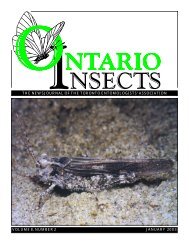1995 - Toronto Entomologists' Association
1995 - Toronto Entomologists' Association
1995 - Toronto Entomologists' Association
Create successful ePaper yourself
Turn your PDF publications into a flip-book with our unique Google optimized e-Paper software.
Ontario InsectsGraduate Student Research in Entomology:April 22, <strong>1995</strong> Symposium AbstractsFEMALE QUALITY AND MATE CHOICE IN THEFIELD CRICKET, GRYLLUS INTEGER. Allen D.MacDougall*, Anne-Marie Murray, and William H. Cade(Dept. of Biology, Brock University).Female crickets respond selectively to variations in speciesspecificmale calling songs. This selectivity has been shownto be age-dependent; older females are less choosy. HOWeever, female quality should also affect female selectivity. Theeffect of female quality on mate choice was examined inGryllus integer by comparing the phonotactic responses offemales on different diets and with different parasite loadsto various synthetic models of conspecific calling song. Testfemales were virgin, 11-14 days old, and had been maintainedon one of five diets varying in protein and fat content.Phonotaxis was quantified using a non-compensating Kugeltreadmill which generates vector scores incorporating thespeed and direction of movement of each female. Test femaleswere presented with four calling song models whichdiffered in pulse rate but were still within the natural rangeof the species for the experimental temperature. After testing,females were dissected and the number of gregarineparasites within the digestive tract counted.Females discriminated among song types preferring lower tohigher pulse rates. This selectivity was apparent in all dietarygroups and did not differ significantly among groups.Highly parasitized females preferred the extreme lower pulserate over the extreme higher pulse rate, irrespective of diettreatment. However, there was no significant relationshipbetween selectivity and the interaction between diet andparasite load on female phonotaxis. These results are discussedin terms of sexual selection and female mate choice.OLD GROWTH WHITE PINE -- ANT ASSOCIATIONS.Leigh Ann Walton* and Sandy Smith (Faculty of Forestry,University of <strong>Toronto</strong>)The ecology of ants in white pine (Pinus strobus) forests iscurrently being studied. The purpose of this study is to answerthree basic questions concerning the ecology of ants:(11 Is there a difference in ants between different regions inOntario? (2) Ifthe forest is old, are ants associated with whitepine different than those associated with other forest types?(3) Are there differences in ants between mature and overmaturewhite pine stands?A preliminary survey took place in July and August of 1994,using pitfall traps and baitboards as methods of sampling.Forty-five plots in three site regions of Ontario were selected,with approximately one third of the plots being over-mature("old-growth") white pine, one third being mature white pine,16and the remaining third being mature forests of other speciescomposition. Pitfall catches have been tabulated, andsignificant results have been found between location andlortype of forest, for various ant species.Using the preliminary study as a foundation, a more intensivestudy will take place during the summer of <strong>1995</strong>. Antswill be looked at from an ecological slant. Ant colonies, andforaging patterns, in addition to species abundance and diversity,will be looked at.GENERALISTS VS. SPECIALISTS: THE EFFECT OFAGRICULTURAL VS. BOREAL FOREST ENVIRONMENTS ON THE ABUNDANCE AND DIVERSITY OFSPRUCE BUDWORM (CHORISTONEURA FUMIFERACLEMENS) PARASITOIDS. Brad Henry* (Department ofEnvironmental Biology, University of GuelphlStudies in New Brunswick, the Gaspe-Ste. Lawrence regionof Quebec, Maine and Northern Ontario have delineated theparasitoid complex which attacks the spruce budworm in aboreal forest environment. To date, no study has examinedthe parasitoid complex in white spruce, Picea glauca (Moench)Voss., plantations in southern Ontario, or plantations in agriculturallandscapes. Several differences were found in therelative abundance of parasitoids collected. Specific parasitoids,Apanteles fumiferanae (Viers) and Glypta fumiferanae(VieLL which accounted for 15-30% and 10-15% of larvalmortality, respectively, in other regions, accounted for a combinedrate of less than 10% in the plantations. Itoplectisconquisitor (Say.), which attacks a variety of Lepidopteranhosts and accounts for 1-8% of pupal mortality in other regions,accounted for 23% of pupal mortality in the plantations.The concept of "generalist" parasitoids being moredominant than specific parasitoids will be discussed.POPULATION STRUCTURE OF A NON-RAINFORESTNEOTROPICAL BUTTERFLY~, EUPTOIETA HEGESIA(NYMPHALIDAE): HOSTPLANTS OR PREDATORS?Phil Schappert* and Joel Shore (Department of Biology, YorkUniversity, North YorklPopulation studies of non-rainforest tropical butterflies areunusually rare. A study of Euptoieta hegesia 1. (NymphalidaeLa coastal lowland species which utilizes a hostplant with discretepopulations, was undertaken to address two questions:1) How vagile is the butterfly population with respect to thediscrete nature of its primary hostplant populations? and 2)What factors limit the size of the butterfly population? Markrelease-recapture(MRR) studies, using a modified Bailey'sTriple Catch design, were conducted at one large and twosmall hostplant populations on the north coast of Jamaica.September <strong>1995</strong>



